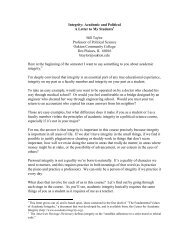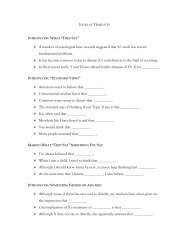united nations advanced certificate faculty - Long Island University
united nations advanced certificate faculty - Long Island University
united nations advanced certificate faculty - Long Island University
You also want an ePaper? Increase the reach of your titles
YUMPU automatically turns print PDFs into web optimized ePapers that Google loves.
CHILD SOLDIERS IN SIERRA LEONE<br />
The Reverend Jose M. Caballero Caceres, MA’98<br />
Sierra Leone is a coastal West African<br />
country that shares borders with Guinea<br />
and Liberia. It has a population of close<br />
to five-and-a-half million (July 2001<br />
estimate) and includes 16 ethnic groups.<br />
The rebel war in Sierra Leone, which<br />
started in 1991 and ended in January<br />
2002, was characterized by a mass displacement<br />
of civilians, looting, the<br />
destruction of homes and infrastructures,<br />
the misuse of economic resources<br />
and terrible atrocities inflicted on the<br />
Father Caballero with Child Ex-Combatants civilian population–amputations, rapes,<br />
mutilations, killings and abductions.<br />
The link between diamonds and armed conflict in Sierra Leone is obvious and has been exposed,<br />
investigated and universally deplored.<br />
A key element to the prolongation of the war was the abduction/recruitment of children into the<br />
fighting forces. Children were perceived to be the best fighters, as they were obedient and easily<br />
manipulated. With over 50% of the population in Sierra Leone under the age of 18 and a war that<br />
has lasted for over 10 years, the number of children who have been used as fighters or camp followers<br />
is unknown.<br />
Children abducted over the years were used as human shields, camp followers and “wives” and,<br />
ultimately, they were trained to be soldiers. Following abduction, they were forced to carry heavy<br />
loads on their heads and were ordered to pick up the weapons of those who were killed should<br />
there be an attack on the group. They spent months trekking over hazardous terrain and many did<br />
not make it to the main camps. All the children were forced to learn to “cock” and “load,” and<br />
their commanders disposed of those who refused to learn. Punishment for not complying with<br />
their new life and trying to run away was death. Those lucky enough not to be killed were tied to<br />
a tree, with AFRC or RUF cut into their chests. Life for girls always started with rape, which was<br />
usually done in full view of others. Girls as young as 10 years of age were forced to have sex on<br />
a daily basis and with whomever. They returned home traumatized, diseased and suffering from<br />
internal injuries.<br />
Many children, some as young as seven years of age, were fighting on the government’s side.<br />
They were initiated into traditional hunting groups that came under the framework of the Civil<br />
Defense Force (CDF). Magical powers were bestowed on these children in initiation ceremonies,<br />
and they were led to believe that they had special powers, such as being “bullet proof.”<br />
2













